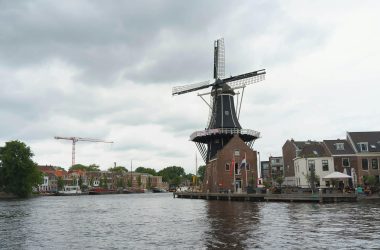Mumbai, India’s financial capital, is not just about skyscrapers and bustling streets—it’s a city steeped in rich history and cultural heritage. From its colonial past to its vibrant present, the city offers a wealth of experiences for history enthusiasts, art lovers, and curious travelers alike. Whether you’re exploring ancient temples, colonial-era buildings, or art galleries, Mumbai has something to offer every type of traveler.
To get the most out of your journey, consider taking the Mumbai Darshan Bus to get an overview of the city or opt for a private experience with Mumbai Darshan Cabs. One experience you definitely shouldn’t miss is the Elephanta Caves Tour, where you can dive into the rich historical past of Mumbai.
1. Start Your Journey with a Visit to the Gateway of India
The Gateway of India is Mumbai’s iconic landmark, symbolizing the city’s colonial history. Built in 1924 to commemorate King George V’s visit to India, the archway stands at the waterfront and offers stunning views of the Arabian Sea. The site is historically significant as it was the place from where the last British troops left India in 1948, marking the end of British rule in the country.
Take a moment to reflect on the historical importance of this site while enjoying a walk along the waterfront. It’s also a great starting point for your exploration of South Mumbai, where colonial architecture and heritage come together in a fascinating blend.
2. Explore the History at the Chhatrapati Shivaji Maharaj Terminus
The Chhatrapati Shivaji Maharaj Terminus (CSMT) is a UNESCO World Heritage Site and a magnificent example of Victorian Gothic architecture in India. Originally known as Victoria Terminus, this busy railway station is not just a transportation hub but a piece of history that tells the story of Mumbai’s colonial era.
The station’s intricate design, with its grand towers, arched windows, and detailed carvings, is an architectural marvel. CSMT is one of the most photographed sites in Mumbai, and its historical significance cannot be overstated. While here, take time to admire the building’s details, which reflect Mumbai’s colonial legacy.
3. Discover Mumbai’s Colonial Past at the Asiatic Society Library
Located in the heart of South Mumbai, the Asiatic Society Library is one of the oldest libraries in the city and a hidden gem for history lovers. Established in 1804, the library has a wealth of historical texts, manuscripts, and books, many of which focus on India’s colonial past.
The building itself is a masterpiece of Neoclassical architecture, with Greek columns and detailed sculptures that reflect the cultural influences of the time. For a quiet retreat and a peek into Mumbai’s intellectual past, the Asiatic Society Library is an absolute must-visit.
4. Dive into Ancient History at the Elephanta Caves
One of Mumbai’s most important historical and cultural sites, the Elephanta Caves Tour takes you to Elephanta Island, where you can explore a complex of ancient rock-cut temples. These temples, carved between the 5th and 8th centuries, are dedicated to Lord Shiva and are a UNESCO World Heritage Site.
The caves’ striking sculptures and the renowned Trimurti statue of Lord Shiva are an important part of India’s cultural heritage. The boat ride from the Gateway of India to Elephanta Island adds to the sense of adventure and discovery, providing you with both historical knowledge and natural beauty.
5. Walk Through History at the Horniman Circle
Located in the heart of the Fort area, Horniman Circle is a historical space surrounded by heritage buildings. This circular garden was once used for recreational purposes by the British elite but today is a peaceful spot amidst the hustle and bustle of the city. The area is home to several buildings from Mumbai’s colonial era, including the Horniman Circle Gardens, the Mumbai High Court, and the Reserve Bank of India building.
Strolling around Horniman Circle will give you a sense of the colonial architecture that defined Mumbai’s skyline in the 19th and 20th centuries. The quiet gardens provide a peaceful escape, offering a moment of respite for those seeking a break from the city’s fast pace.
6. The Heritage of Mumbai: Visit the Dr. Bhau Daji Lad Museum
Mumbai’s history is not just about colonialism—it’s also a reflection of its indigenous culture and craft. The Dr. Bhau Daji Lad Museum, located in Byculla, offers a comprehensive look at Mumbai’s development from a small island settlement to a bustling metropolis. The museum is housed in a beautiful Victorian-era building and showcases a fascinating collection of artifacts, including ancient pottery, sculptures, textiles, and models of Mumbai’s early structures.
This museum offers a deep dive into the city’s history, providing valuable insights into the lives of Mumbai’s early inhabitants and the cultural evolution of the region. For a traveler seeking to understand Mumbai’s roots, this museum is an essential stop.
7. Explore the Art and Culture at the Chhatrapati Shivaji Maharaj Vastu Sangrahalaya
Known locally as the Mumbai Museum, the Chhatrapati Shivaji Maharaj Vastu Sangrahalaya is a treasure trove of art, archaeology, and natural history. Located in the heart of the city, the museum houses an extensive collection of Indian and international art, including sculptures, paintings, and decorative arts.
Visitors can explore galleries that showcase ancient Indian artifacts, Mughal miniatures, and even textiles from India’s colonial past. The museum also hosts special exhibitions, making it a fantastic place to spend a few hours exploring the country’s rich artistic heritage.
8. Visit the UNESCO Heritage Site: The Kanheri Caves
Located in Sanjay Gandhi National Park, the Kanheri Caves offer a glimpse into ancient Buddhist history. These caves were used by Buddhist monks for meditation, prayer, and teaching. With over 100 caves carved into the rock, the site provides a serene retreat from the city and a deep dive into Mumbai’s Buddhist heritage.
A visit to the Kanheri Caves also provides an opportunity to explore the lush greenery surrounding the area, offering a perfect blend of history and nature. The caves, along with the peaceful atmosphere, create a perfect destination for history buffs and nature lovers alike.
9. Discover the Religious Heritage of the City at the Siddhivinayak Temple
Mumbai’s religious landscape is as diverse as its people, and one of the most important religious sites in the city is the Siddhivinayak Temple, dedicated to Lord Ganesha. This Hindu temple is not only a place of worship but also a symbol of Mumbai’s spiritual heritage.
The temple, located in the heart of the city, is a pilgrimage site for millions of devotees. The intricate architecture and the revered idol of Lord Ganesha attract visitors from all over India and the world. For travelers interested in spirituality and religious history, the Siddhivinayak Temple offers a deep connection to the city’s cultural fabric.
10. End Your Day with a Sunset at Marine Drive
To wrap up your day in Mumbai, head to Marine Drive, known as the Queen’s Necklace for its streetlights that form a beautiful arc around the bay. This iconic waterfront is not just a perfect spot for a leisurely walk, but it also offers a stunning view of the sunset over the Arabian Sea.
As the sun sets behind the horizon, the lights of the city begin to twinkle, creating a magical atmosphere. Marine Drive is the perfect place to reflect on your day of exploration and immerse yourself in the charm and allure of Mumbai’s cultural and historical landscape.
Conclusion
Mumbai’s history and culture offer a fascinating journey for travelers seeking to explore beyond the modern facade. From the Elephanta Caves Tour to the grandeur of the Gateway of India and the colonial-era architecture of the city, there’s no shortage of places that reflect Mumbai’s rich past. With options like the Mumbai Darshan Bus and Mumbai Darshan Cabs, you can explore these sites comfortably and in-depth, ensuring an enriching experience that blends history, culture, and stunning sights.







